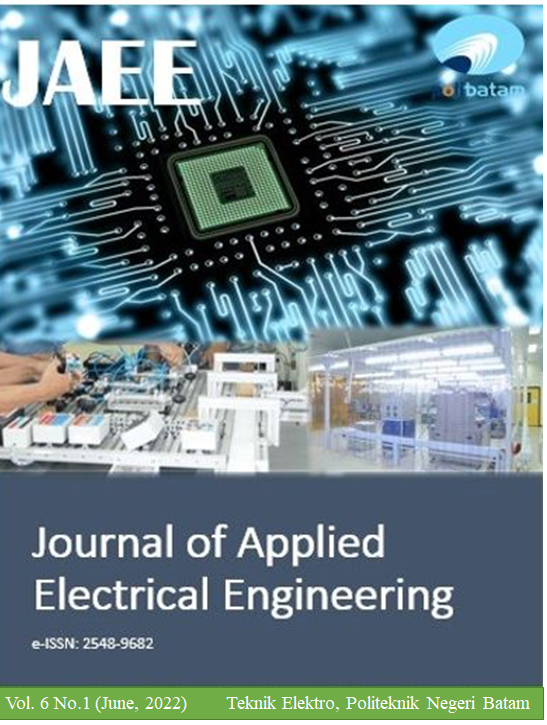Sistem Kendali dan Monitoring Infus Berbasis Internet of Things
DOI:
https://doi.org/10.30871/jaee.v6i1.4017Kata Kunci:
Internet of Things, Servo SG90, Photodioda, MQTTAbstrak
Intravenous therapy is a way to give fluids into the body through a vein to replace lost fluids. Problems that occur with the use of intravenous therapy include air embolism or blood rising into the infusion tube, the number of drops is not as needed, and the infusion volume vacancy, if not treated quickly, will cause blood to rise to the infusion tube. Monitoring and regulation of infusion drops can be done automatically, using the SG90 servo motor, photodiode sensors and internet of things technology, using the MQTT protocol as a communication protocol that is capable of sending data in real-time. This study makes a device that is able to detect bubbles and blood in the infusion tube, adjust the infusion drip automatically with an average drop per minute error of 2.67% at 20 DPM set point and 1.67% at 60 DPM set point, and speed the average data transmission to the server is 0.134 seconds with WIFI signal strength between -62.2 dB to -85.4 dB.
Unduhan
Referensi
R. Sumara, "Hubungan Lokasi Terapi Intravenus Dengan Kejadian Plebitis," J. Keperawatan Muhammadiyah, 2017, doi: 10.30651/jkm.v2i1.926.
D. D. W. I. ANANDA, S. Purwanto, and Z. Effendi, "Pengembangan Prototype Alat Pemantau Adanya Infiltrasi, Emboli Udara Dan Jumlah Cairan Pada Infus," Sriwijaya University, 2021.
S. N. U. R. A. Nimawati, "Gambaran Kejadian Kekosongan Infus Pada Pasien Rawat Inap Di Rsud Ajibarang," universitas muhammadiyah purwokerto, 2019.
A. Rahmatulloh and M. S. N. Firmansyah, "Implementasi load balancing web server menggunakan haproxy dan sinkronisasi file pada sistem informasi akademik Universitas Siliwangi," J. Nas. Teknol. Dan Sist. Inf., vol. 3, no. 2, pp. 241"“248, 2017.
A. U. Rahayu, "Sistem Monitoring Perilaku Pengendara Mobil Berbasis Internet of Things," JITCE (Journal Inf. Technol. Comput. Eng., vol. 5, no. 01, pp. 18"“24, 2021.
S. Sadler, "The Bateson Building, Sacramento, California, 1977--81, and the Design of a New Age State," J. Soc. Archit. Hist., vol. 75, no. 4, pp. 469"“489, 2016.
N. Nurkholis, J. Junaidi, and A. Surtono, "Rancang Bangun Sistem Akuisisi Data Resonansi gelombang Bunyi Menggunakan Transduser Ultrasonik Berbasis Mikrokontroler ATmega8535," J. Teor. dan Apl. Fis., vol. 2, no. 2, 2014.
H. Jaya, "Desain dan Implementasi Sistem Robotika Berbasis Mikrokontroller." Edukasi Mitra Grafika, 2016.
R. A. Atmoko, Dasar Implementasi Protokol MQTT Menggunakan Python dan NodeMCU. Mokosoft Media, 2019.
M. Kashyap, V. Sharma, and N. Gupta, "Taking MQTT and NodeMcu to IOT: communication in Internet of Things," Procedia Comput. Sci., vol. 132, pp. 1611"“1618, 2018.
F. M. S. Nursuwars and A. Rahmatulloh, "RFID for nurse activity monitoring in the hospital's nurse call system with Internet of Thing (IoT) concept," in IOP Conference Series: Materials Science and Engineering, 2019, vol. 550, no. 1, p. 12025.
A. Solichin, Pemrograman web dengan PHP dan MySQL. Penerbit Budi Luhur, 2016
Unduhan
Diterbitkan
Cara Mengutip
Terbitan
Bagian
Lisensi
Authors who publish with this journal agree to the following terms:
- Authors retain copyright and grant the journal right of first publication with the work simultaneously licensed under a Creative Commons Attribution License (Attribution-ShareAlike 4.0 International (CC BY-SA 4.0) ) that allows others to share the work with an acknowledgment of the work's authorship and initial publication in this journal.
- Authors are able to enter into separate, additional contractual arrangements for the non-exclusive distribution of the journal's published version of the work (e.g., post it to an institutional repository or publish it in a book), with an acknowledgment of its initial publication in this journal.
- Authors are permitted and encouraged to post their work online (e.g., in institutional repositories or on their website) prior to and during the submission process, as it can lead to productive exchanges, as well as earlier and greater citation of published work (See The Effect of Open Access).
Open Access Policy
This journal provides immediate open access to its content on the principle that making research freely available to the public supports a greater global exchange of knowledge. Its free availability on the public internet, permitting any users to read, download, copy, distribute, print, search, or link to the full texts of these articles, crawl them for indexing, pass them as data to software, or use them for any other lawful purpose, without financial, legal, or technical barriers other than those inseparable from gaining access to the internet itself.














